By Kent McFarland and Bryan Pfeiffer
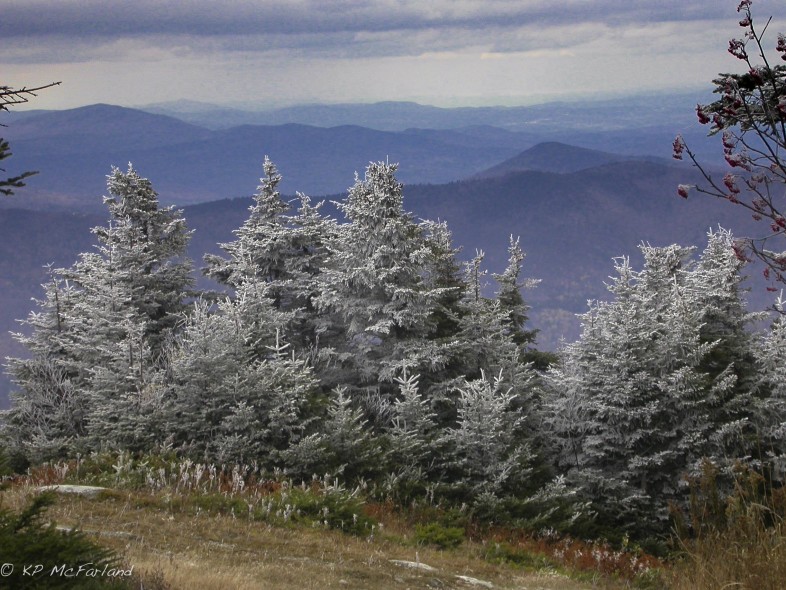
Balsam Fir covered in rime ice in early December on Pico Mountain, Vermont. /© K.P. McFarland
Fear not, during these short days and long nights of December, we’re still finding plenty of life in the fading light. Once we pass the winter solstice, which strikes near midnight on the December 21, more light will begin to creep back into our lives. Until then, here’s some wintry natural history to keep you going.
ice and wind drives the Fir waves
Economically and ecologically important, Balsam Fir is a keystone species of the eastern North American boreal zone. The provincial tree of New Brunswick, Canada, it can form dense single species stands in some areas of northeastern North America, especially in the high mountains.

Fir waves on Whiteface in the Adirondacks, NY. /© K.P. McFarland
High-elevation forests are often marked by “fir waves.” These are crescent-shaped bands of dead trees that you can see in systematic patterns across the sides of the mountains. The waves are areas of standing dead fir trees with healthy trees surrounding them. Fir waves move very slowly, over decades, in the direction of the prevailing wind. Wind velocity at the edge of the tree canopy is over 50% higher than within the forest. Rime ice forms on the trees when water droplets in the air hit solid surfaces and immediately freeze. Rime accumulates more on trees exposed to wind.
Trees at the leeward edge of the canopy opening in the wave are exposed to winds and die from loss of needles and branches due to heavy ice accumulation. The rocking in the wind with ice loads also causes their fine rootlets to break underground. These rootlets are important for delivering nutrients to the tree. As these trees die, adjacent trees experience the same conditions and begin to die. The overall direction of the wave motion is therefore directly related to wind direction.
Regeneration of waves occurs at about 60 year intervals. As you move back from the dying front of trees the trees are older and older until you reach the following wave of dead trees. If you were to take time lapsed photography of a mountain side, the waves of dead trees would appear to be moving across the mountainside like a wave in the ocean. Learn more about Balsam Fir on our web site.
A Growing Brain

Black-capped Chickadee (Poecile atricapillus) carrying a seed. /© K.P. McFarland
The next time you are rushing around your house looking for your car keys, you might think about the chickadees at your bird feeders.Chickadees prepare for the onslaught of winter by storing food. They hide thousands of food items. With a brain the size of a pea, how do they remember where they are?
They grow extra brain cells. The hippocampus region of their brains expands in volume approximately 30 percent each fall with the addition of new nerve cells. This region of the brain is an important area for making new memories, especially spatial memories. Read more from Kent McFarland at Outside Story.
Pine Cones on a Willow?
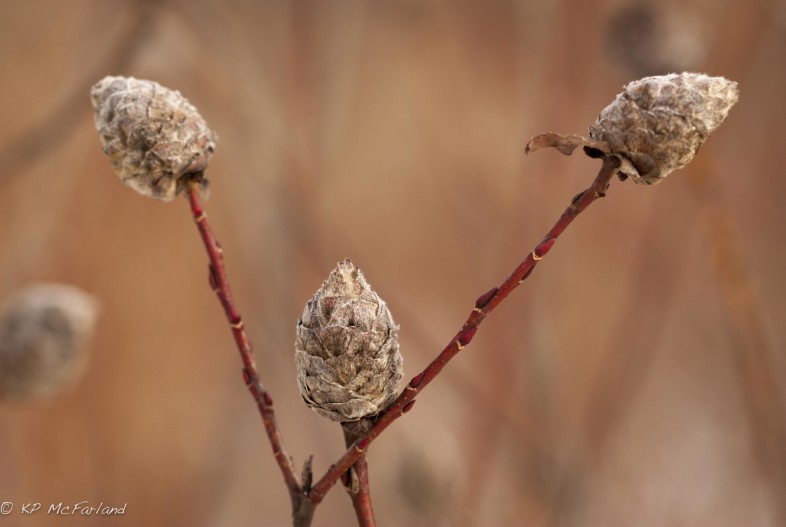
Galls of the Pinecone Willow Gall-midge (Rhabdophaga strobiloides). /© K.P. McFarland
Have you ever seen pine cones on the end of willow branches? They aren’t really pine cones, they are protective homes for the Pine Cone Willow Gall Midge (Rhabdophaga strobiloides), a type of fly that relies on willows for its home.
The adult gall-midge lays its egg on the tip of a willow branch as the terminal buds begin to swell in the early spring. The egg, and larva that hatches, release a chemical that tricks the growing willow leaves into forming a structure that looks superficially like a pine cone made of overlapping leaves.
As the larva feeds the bud ceases to develop, but the plant still directs nutrients to the tissues. Biologists working at the University of Michigan Biological Station at Pellston, Michigan, found that somehow the gall-midge manipulates the willow to provide resources from other places in the plant to the gall for them to continue to feed and survive. They found that galled twigs compared with normal twigs had greater growth in twig girth than when no gall is present and twigs with galls grew equally well with or without leaves. The bud continues to swell as the larva feeds and grows. When winter sets in, encased in the cone structure, the larva is protected from predators, but not from the cold.
The larvae aren’t freeze tolerant. Instead, they rely on extreme supercooling, the process of lowering liquid temperatures to below the freezing point without becoming a solid. How do they do this? Overwintering willow gall larvae can contain as much as fifty percent glycerol, historically used in cars as anti-freeze. Some individuals in Alaska were found to have extreme supercooling that allowed them to survive down to -76 degrees Fahrenheit.
At some point in the spring, the larva will pupate and the adult gall-midge will emerge. They don’t have mouthparts to chew their way out of the gall. Instead, they simply push and squeeze between the overlapping leaves of the gall and fly away.
A Warm and Cozy Cavity
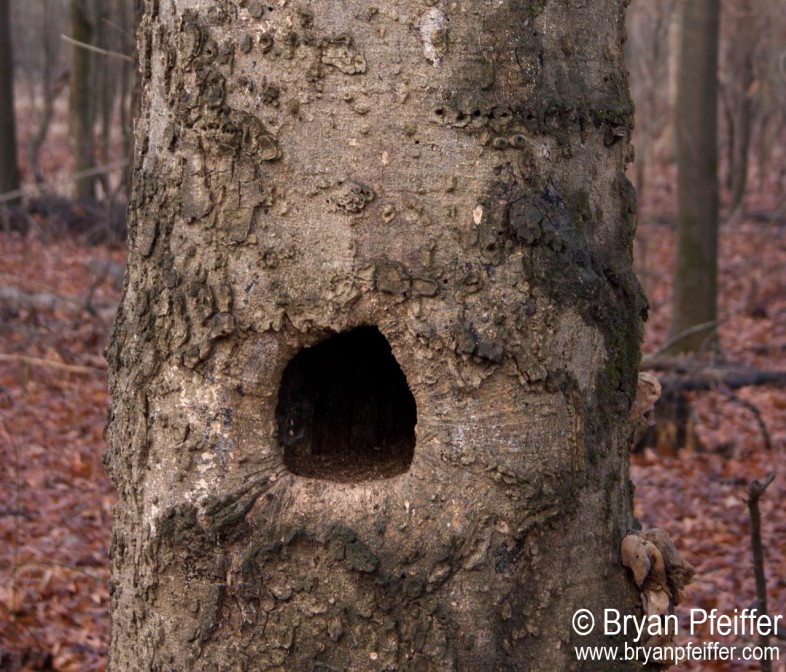 Tree cavities can mean the difference between life and death for birds and small mammals during a cold winter night. With a large surface to volume ratio they can lose heat quickly. Add wind to mix and life becomes even more difficult for small animals.
Tree cavities can mean the difference between life and death for birds and small mammals during a cold winter night. With a large surface to volume ratio they can lose heat quickly. Add wind to mix and life becomes even more difficult for small animals.
But not all tree cavities are created equal. The mean temperature differential between the cavity and the outside temperature can be as high as 9 degrees F. But it increases with higher day-to-night fluctuations in the ambient temperature, a smaller cavity entrance and better cavity tree health.
Squirrels den in tree cavities during winter, especially during high winds. One occupied cavity was 47 F when the outside temperature fell to a low of -4 F. The temperature in an occupied Raccoon den immediately begins to rise and remains more stable than outside air. A drop in outside temperature can be delayed by as much as two hours inside the cavity. In one den the temperature only changed 2 F while the outside temperature fell 23 F in an hour.
Because not all cavities are created equal, animals must choose the best site to roost at night. There is probably some level of competition between them. The predictors of microclimate – tree health and entrance size – may provide indirect cues to prospecting animals.
KISS THIS: A HIGHER CALLING FOR MISTLETOE
Get yourself under some wild mistletoe this Christmas. Your gift might be a shock-and-awe butterfly called Great Purple Hairstreak.
Mistletoe is a plant that grows on trees or shrubs. And it’s a bit of a leech, a hemiparasite, which means mistletoe draws minerals and fluids from its host. But mistletoe is also photosynthetic, generating some of its own energy demands from sunshine. Oh, by the way, there is no one mistletoe. The world has more than 1,000 mistletoe species. Mistletoes grow flowers, have pollinators, and produce fruits like many other plants.
In Arizona last December, among thousands of butterflies, I encountered a single Great Purple Hairstreak. That’s usually how we find them, sluggish and alone, about the size of your thumbnail, crawling among flowers and lapping up nectar. But the business side of this butterfly, at least when it comes to mistletoe, is the caterpillar. Great Purple Hairstreak caterpillars eat mistletoe species in the genus Phoradendron (and maybe others).
After all, for butterflies, it’s all about the host plant – the plant on which (or near) the adults lay eggs and on which the caterpillars feed. So if you’re looking for a particular butterfly species, start by looking around its host. Great Purple Hairstreaks range across central and southern latitudes of the US, where we find a lot of that mistletoe. (Sorry, northerners.)
But this isn’t to say that we don’t have mistletoe up north. I’ve seen dwarf mistletoe (Arceuthobium pusillum) near home (where it’s rare) on black spruce in a bog in central Vermont. Dwarf mistletoe is an odd beast whose young shoots look, um, er, well … you’ll see below.
So, here you are, a few more photos: First, another Great Purple Hairstreak, which I photographed in Delaware; on this one you can see just a bit of its shocking orange abdomen. Then the mistletoe outside my cabin here in New Mexico (where I’m wrapping up a book of essays, by the way).
Oh, by the way, Olivia Judson scooped me with a wonderful essay on mistletoe in The New York Times, although she didn’t mention Great Purple Hairstreaks.
– Bryan Pfeiffer
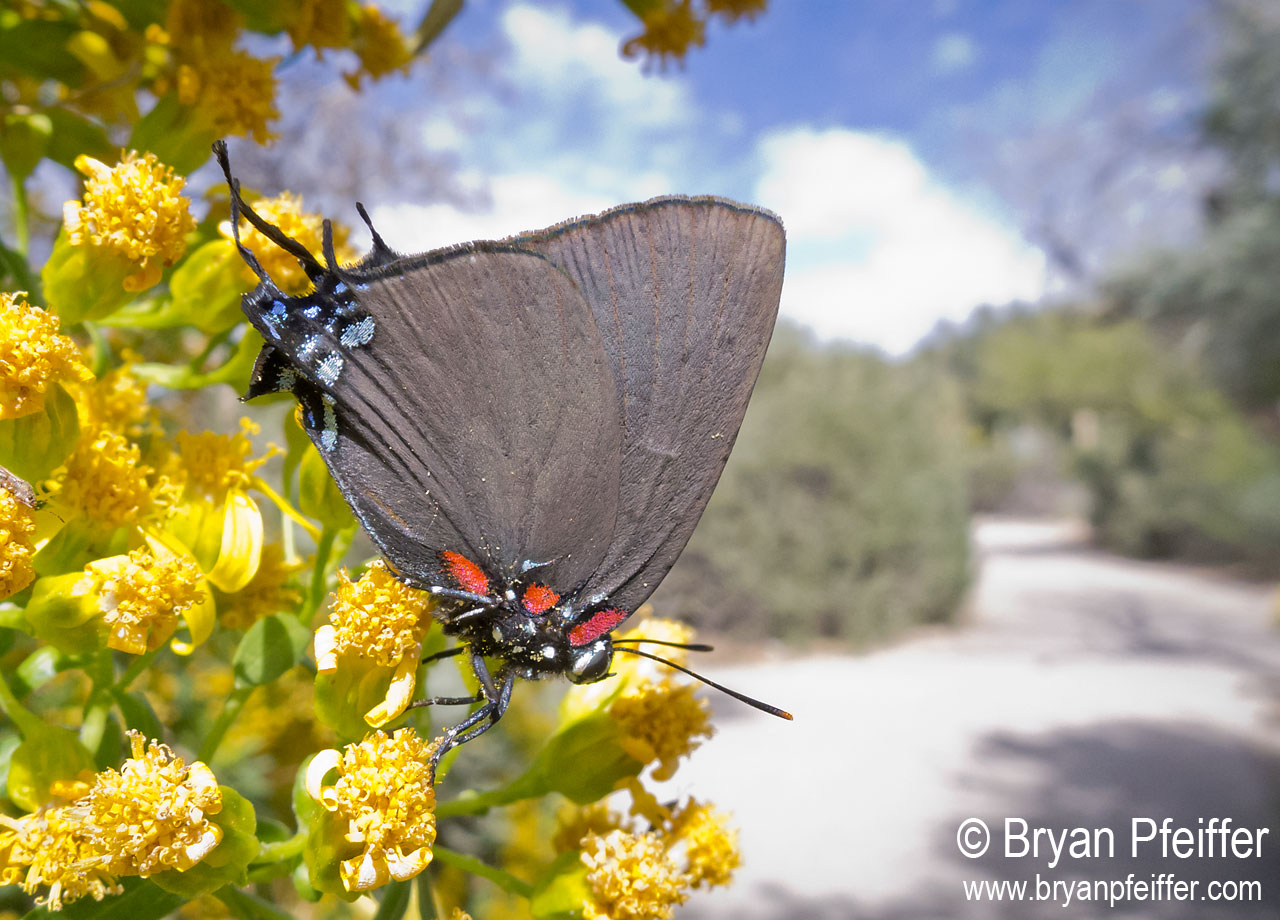
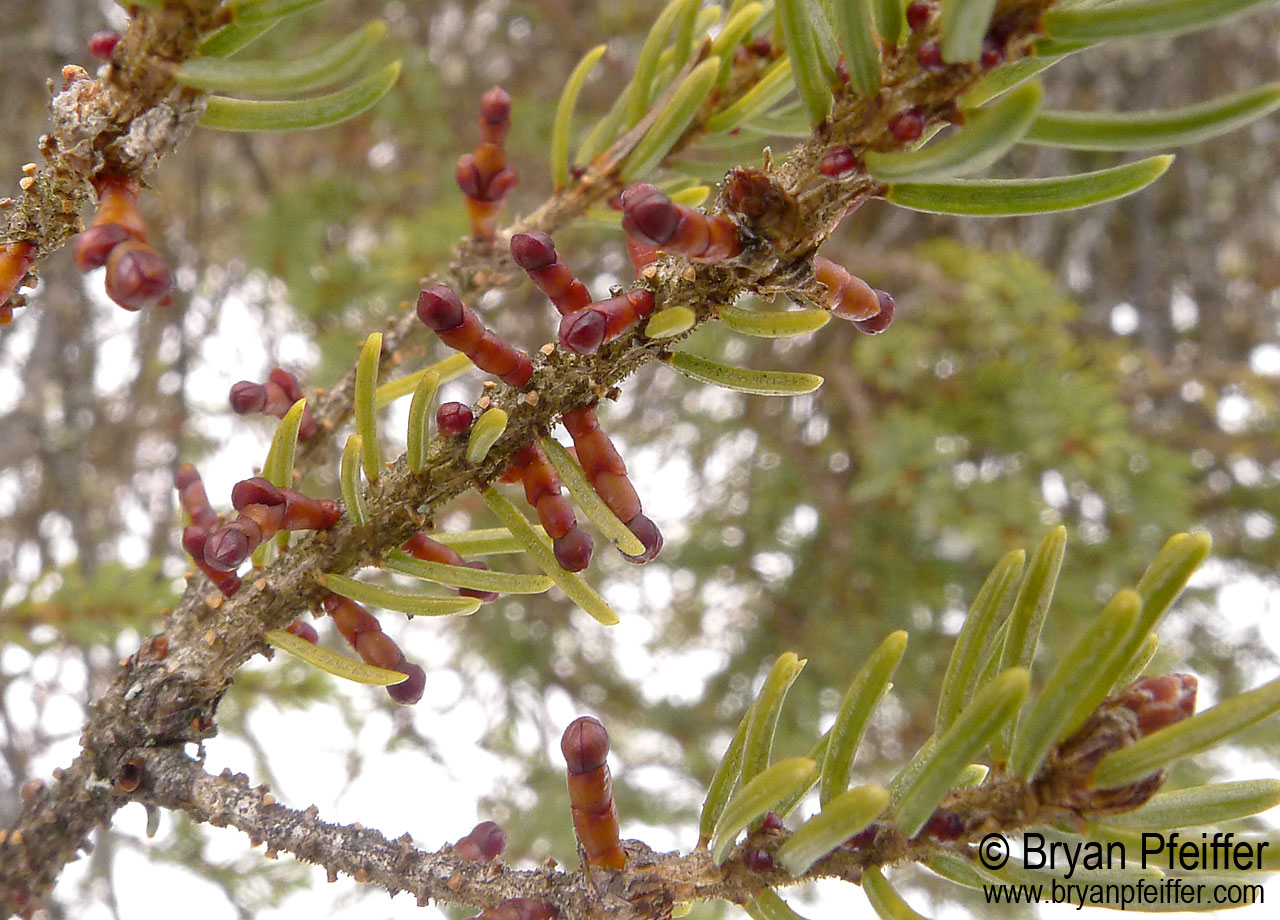
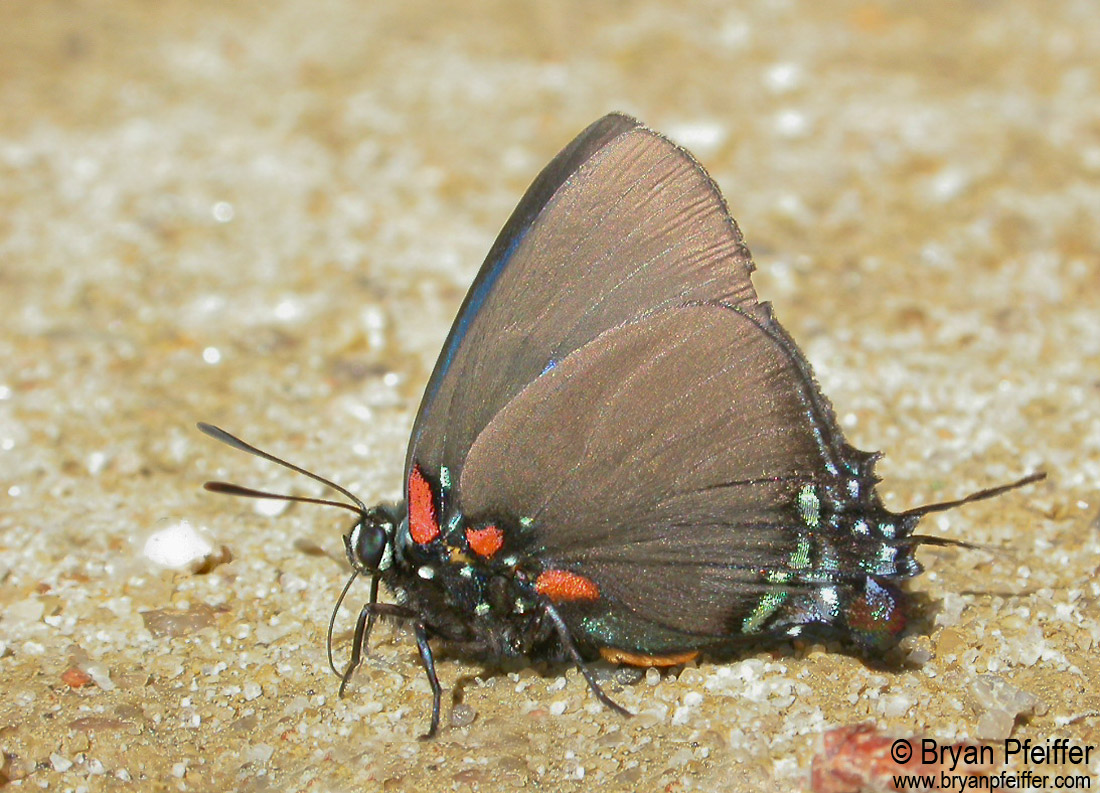
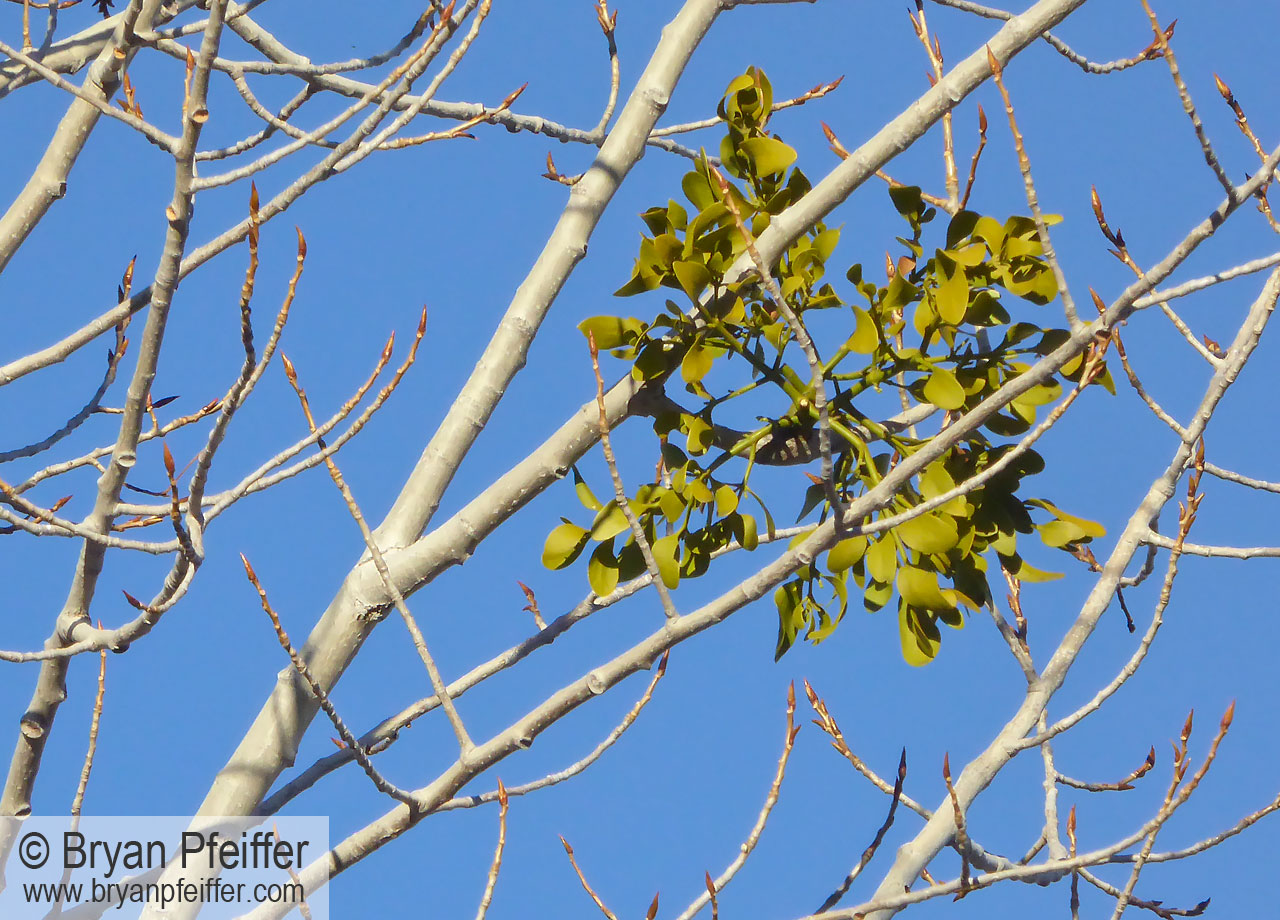

This is one of the best emails I’ve received from you. e.g.: the explanation of fir waves, which I’ve never completely understood. Also the chickadees’ clever brain adaptation….even the mistletoe’s explanation. I’ve always thought that the holly with berries symbolizes masculinity, while the mistletoe represents the female. H’mmmmm…
I did leave a comment, see above, on the winter topic. If you can’t find it, let me know (802) 985-8765.
I’ve been trying to identify that “shrub” with “pinecones” unsuccessfully for the last 2 years. Now I know!